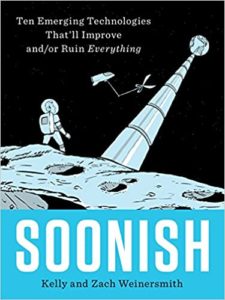
Soonish: Ten Emerging Technologies That’ll Improve and/or Ruin Everything
By Kelly and Zack Weinersmith
368 pages
Published Oct. 17, 2017 by Penguin Press
Soonish is a fun and fascinating look at transformative technologies that are just around the corner – from robot swarms to nuclear-fusion-powered toasters. Through research and interviews with scientists, the Weinersmiths explore why these innovations are useful, how they might work, and what obstacles for implementation stand in their way.
A brief list of technologies covered:
* Space Exploration: It’s expensive to get into space. The solution, according to Soonish, is space planes, space elevators, and asteroid mining.
* Fusion Power: Something is going on at Sandia Labs with an experiment known as the MagLIF project. It has to do with fusion – splitting atoms. I didn’t understand it, but it sounded exciting. I’ll have to read that chapter again.
* 3-D Printing of Houses: In China, the company WinSun has cleared an impressive hurdle. The company prints the walls and other components of the house, layer by layer, in its factory, and then assembles them on site.
* 3-D Printing of Human Organs: This is a field of study that is well advanced but stalled. The challenge lies in figuring out how to recreate the tiny blood vessels that are vital to organ function. But have no fear. At Rice University, a team led by Dr. Jordan Miller has been working on it.
* Programmable Matter: This sounds crazy, but Soonish imagines a future house that can change its structure depending on the weather. The Weinersmiths argue that this is not just possible, but already in the works.
* Synthetic Biology: An emerging field of study that relies on DNA manipulation to eradicate disease. Recently, biologists figured out how to manipulate the bacterial immune system in a way that allows them to cut DNA at a specific location, remove a piece from one organism’s DNA and add it to another’s. The technology (CRISPR-Cas9) could enable us to do things like cut potential diseases out of human embryos or change the eye/hair color of your future child.
* Precision Medicine: A better and quicker way to diagnose and treat sickness and disease using biomarkers that may be able to instantly detect any unwanted molecules entering your bloodstream, cancerous growths, or even symptoms relating to depression.
* Brain Computer Interfaces: Who knows where this field will lead us? Right now, progress is being made on developing brain-computer interfaces to fix problems like blindness and paralysis. And a deaf patient can now receive a cochlear implant, which uses a small microphone to deliver sounds to a receiver in the patient’s skin. The receiver then translates the sound into electrical signals that are sent to the inner ear. The result has been described as sounding like a low-quality cassette tape recording, which is still far better than silence.
Critical Reception
“An entertaining look at future tech wizardry, from space tourism and asteroid mining to nuclear fusion power, matter replication, synthetic biology and direct brain-computer interfaces…. The text is very well-researched, with a casual, friendly style (‘Tinkering with the language of life. What could go wrong?’), and color cartoons add a wry counterpoint to the narrative of a future that, as always, might be utopia or disaster.” (Steven Poole, Wall Street Journal)
“Curiosity is a beautiful thing, and Kelly and Zach Weinersmith have it in spades. Their coauthored Soonish is an unabashed nerd-out of a book, zinging from outer space to DNA, hardly pausing for breath…. The gleeful geeking out makes for a great read – I couldn’t help chuckling or outright cracking up a number of times – while surreptitiously teaching some really important science. It’s a winning combination. The sheer breadth of topics covered is also amazing: Probably no other book in history has seriously described the science behind both tentacle construction robots and the human nasal cycle.” (Colin McCormick, Science)
“Fans of science, math, or medicine; gamers; and those who love the weird and wonderful will gravitate to this volume.” (School Library Journal)
 MarkFord
MarkFord